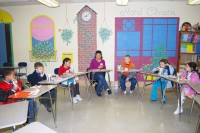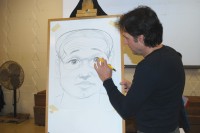April 7, 2010 // Local
Young authors’ conference empowers creative writing
By Karen Clifford

Parent leader Tanya Martinez leads a group of young authors as they share the stories written especially for the conference.
MISHAWAKA — “Creative writing is empowering. Children don’t get to go to school and decide that two plus two is five and the capital of Indiana is Albany; they’d be wrong. But creative writing allows them to decide what’s right and wrong for their story. Writing and drawing are worlds where a child can decide what happens.”
These words are the reflection of Peter Catalanotto, Pratt Institute graduate, children’s book author and illustrator, and guest author at the Catholic Schools’ 17th annual Young Authors’ Conference at Marian High School. Approximately 450 students from 11 area schools participated in the half-day event which included Catalanotto, nationally acclaimed area children’s book illustrator Bruce Langton, and a presentation by St. Joseph Catholic School second-grade teachers Mary Young and Ana Maria Lewis for parents.
Suzanne Wiwi, principal of St. Joseph Catholic School in South Bend and chair of the Young Authors’ Conference, explained the concept of the event.
“The original premise, which continues today, for having this conference, was to encourage the reading-writing connection. Learning the writing process and applying it to their own writing is important as well as encouraging students to let their writing, ‘tell a story.’ Authors are asked to focus on their own writing as well as their love for literature and expression through their books. Authors often illustrate their own books, so that component is often emphasized.”
She continued, “This year we have an author who is also an illustrator. Our second presenter is a local illustrator who was a feature author several years ago; he was so well received by the students we decided to have him return again this year. We also provide speakers who address parents; giving them ways they can help their child with reading and writing.”
The morning event included small group sharing by students with a simultaneous parent presentation by teachers Young and Lewis, a presentation on the process Catalanotto uses to create a character’s face for his books, and students participation in making pictures with illustrator Langton.
During one of the student small group sessions, Marisol Martinez, a third grader at St. Pius X School, discussed her story “Two Crews in One,” with fellow young authors.
“It is about a dog crew and a cat crew, who after being rivals for sometime, unite their crews to form one. The dogs always chase the cats and win all the games played. The cats decide one day to break into the dog’s hideout and find an unwanted surprise.”
At the parent presentation, “Reading is Thinking about the Words on a Page,” given by Young and Lewis, the importance of parental participation in their child’s reading development was stressed.
“We want students and parents to understand there are two voices involved in reading. There is a reading voice, which is reading the words on the page and a thinking voice, which are the questions, thoughts and interactions you have while reading. Reading is thinking about the words on a page,” said Young.
Lewis added, “Good readers read a variety of literature that exposes them to different types of writing. Good writers don’t become good writers by writing things over and over. Good writers learn how to become good writers by reading. By making parents aware of the reading strategies, they can help their child become a better reader.”

Guest author and illustrator Peter Catalanotto, explains the drawing process he uses when developing a character for his books.
Students at the Langton session made their own drawings with step by step direction from the illustrator. Langton noted many of the schools he visits do not have the resources to develop their students’ artistic skills.
“I love to illustrate and have been an artist all of my life. Lots of schools where the budgets are being cut don’t have art teachers, so schools are receptive for having me come into their schools in giving talks and teaching kids how to draw. For children you have to keep the illustrations simple,” said Langton.
Catalanotto showed students that by adding shadows when drawing a character’s face, it becomes three dimensional. The audience communicated their delight with laughter as he showed how eyebrows can be drawn different ways to give a character expression.
The important thing for children to remember when writing, Catalanotto emphasized, is to enjoy the writing experience. “(I tell students) to be true to their story. They can put whatever they want in their stories as long as it works for that story. That means looking for their best ideas, not simply using their first ideas. While looking for their best ideas they’re going to make mistakes and that’s okay. Mistakes are an important part of the process. If you create an entire book without making any mistakes that means you didn’t try anything new and you probably made a pretty boring book.”
The best news. Delivered to your inbox.
Subscribe to our mailing list today.






